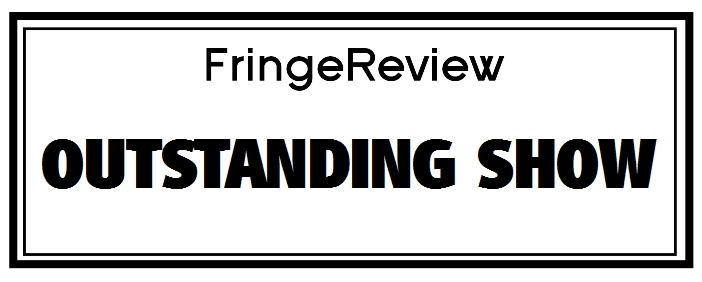FringeReview UK 2016
Joan, Babs & Sheila Too
Conscious Theatre

Genre: Cabaret, Comedic, Community Theatre, Drama, Fringe Theatre, New Writing, Short Plays, Solo Performance, Theatre
Venue: Sweet Venues Dukebox The Iron Duke
Festival: FringeReview UK
Low Down
Gemskii’s Joan, Babs & Sheila Too, directed by Olive Senton to the Iron Duke’s Dukebox, part of SweetVenues. It’s brought by Conscious Theatre,Callum Wyles and Dan DaChuna Blaker with sound, music by Richard Norris, set by Jack Silver and projection involving Kristina Lankina’s photography.
Review
Conscious Theatre have brought Gemskii’s Joan, Babs & Sheila Too, directed by Olive Senton to the Iron Duke’s Dukebox, part of Sweet Venues.
It’s a quite stunning one-person show with a substantial team supporting: Callum Wyles and Dan DaChuna Blaker with sound, music by Richard Norris, set by Jack Silver and a deft use of projection involving Kristina Lankina’s photography.
The title cheekily references Andrea Dunbar’s 1982 Rita, Sue and Bob Too, a play which could perhaps summarize the seismic shift in theatre caused by Joan Littlewood (1914-2002) who should as Gemskii says resoundingly here, be a household name. From Agitprop in grand houses to Grand Dame herself, to a final sad postlude from theatrical life lasting twenty-seven years, Littlewood brought improv, audience participation, kitchen sinks and a chopping-block raft of innovations sliced by the war. And of course her 1963 masterpiece Oh What a Lovely War!
The set is remarkable too, seemingly a simple reversible large plaque from which Gemskii dances on as Babs Windsor and everyone else, but which also doubles as a screen with projected words Gemskii faultlessly recites and comments on in synch with rapid shifts of letters and images. The tight professionalism of this lifts the show footlight years away from what you’d expect in a small pub platform.
Gemskii both writes and acts in this hyper-active ventilation of Joan Littlewood’s life. The other two names referenced are Barbara Windsor and Shelagh Delaney who wrote A Taste of Honey with much input from Littlewood, and who became a surrogate daughter.
Gemskii begins with Littlewood’s difficult childhood, her mimicry, RADA scholarship, starving pilgrimage to Manchester – she gets as far as Derby and a kindly woman puts her on a train – and to her long association with Ewan McColl (as he became).
To recite even quip by quip might prove more edifying than charting Littlewood’s rise to pre-eminence, but it’s important as Gemskii stresses, to register Littlewood’s impact. After picaresque wanderings more strange than Priestley’s troupe in The Good Companions, we’re treated to a split of aesthetic after a French tour. One is to go with agitprop – McColl’s U235 is hinted at, an astonishing play in itself about nuclear fall-out from 1952 which predates When the Wind Blows by over 30 years. The other is in its way radical too: music hall, pleasing the masses not theatre-goers, and radical re-readings of classics like Ibsen, this being the preference of upper-middle-class Gerry, who became Littlewood’s later partner. McColl having also been imprisoned as a deserter whilst residing at the country house deprives Littlewood and the company of both him and house in one cuff. It’s Gerry who discovers Theatre Royal Stratford East, the company’s permanent home.
Gemskii flits with amused dignity between costumes, winking raucous Windsor, her dungaree’d earlier self or the later familiar peaked mob cap of her grand years, which meant playing the part of the skivvy and auditioning unsuspecting actors whilst chortling as char – ‘you got the part on the stairs’ Windsor was later told, doing a double-take as the char confronted her.
The wardrobe is faultless, as is the synchronisation with projected scripts, timing, delivery and a battery of audience members cajoled or poked, kissed or chaffed as members of MI5. And there are sing-songs. It’s Littlewood’s echt-music-hall mode updated and here re-deployed to tell her story.
Gemskii knows what to leave out: although U235 is referenced, it isn’t named, the story paramount and thus edited highlights keeping Littlewood’s quiddity and innovation at the forefront. Jokes about sexual fulfilment, boring lovers, wartime privations and collapsing buildings trip you up with laughter, but you’re compelled to listen on more than dwell on them. Gemskii figures those who know will pick up references, and those who don’t would be otherwise pummelled with facts and in this lighter manner will discover by osmosis.
Not that Littlewood is whitewashed: ruthless and tribal on occasion, she could cut up even Delaney who threatened to rush off in a huff to the Royal Court having had her second play slammed (probably with reason). Gemskii donning yet another wig re-enacts Delaney’s older self, relating her petulant rebellion and dismissal with amused pathos. Demotics were her watchwords.
In around seventy-five minutes Gemskii manages both a voyage around Littlewood and the defining shift of 20th century theatre. It’s difficult as we and the props sway and she remains upright, to realise the show’s over. This flashmob of Littlewood couldn’t be bettered. Senton’s direction is as tight as Gemskii’s sinewy, confiding and welder-riveting performance. We learn much from laughter, occasional pathos, and an iron purpose with jokes like lost needles.

































